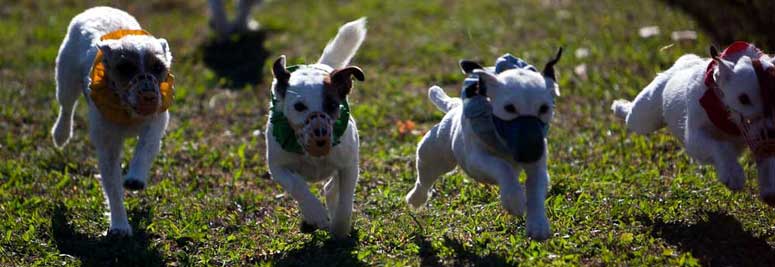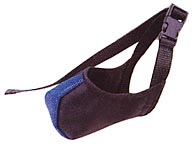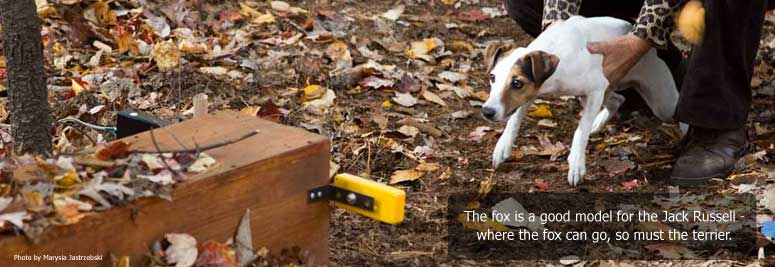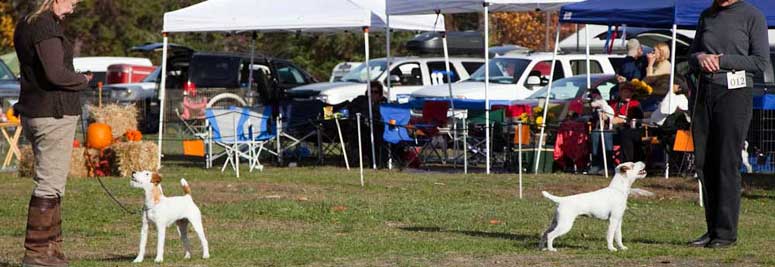Jack Russell Terrier Trialing 101
This article by JRTCA member Erin Schwartzkopf provides an introduction guide to a JRTCA sanctioned terrier trial including what to expect, what to bring and how to enter various events.

With trial season coming in full swing, there may be some of you out there that might like to go but aren't sure what to expect, or may believe that there are some special requirements or training needed to attend. The only real requirements (except for Nationals) are that you are a JRTCA member and have a Jack Russell Terrier. Oh yeah, and you have to want to have a good time! This article is for you. Hopefully it will help give you an idea of what to expect and encourage you to go for it. Over the next several paragraphs, I will be referring to trials in general. Not all trials run in the same order or exactly the same. This is intended to give you a little bit of introduction to ease any anxieties or tentativeness you may have about trials.
Welcome, students, to Trialing 101
We were all nervous for our first trial and many of us are still nervous!
We've all been there. Every one of us had to attend our "First Trial." We've all been nervous, all been worried that we'd fall on our faces or be laughed out of the ring. Some of us still feel that way. We went anyway. Some have fallen on their faces even! Literally! When I was getting ready to attend my first trial, my only reference was the "dog shows" I'd seen on TV. Man, was I in for a surprise! Terrier trials are NOTHING like what I'd seen on TV. I'd expected something stuffy and uncomfortable. I found out quickly that they are anything but stuffy and uncomfortable! Many trial exhibitors are still nervous at trials after several (sometimes many) years of trialing. It is, after all, a competition. At least, it is when you only look at the bare bones of a trial. So, just remember you're not alone. We were all nervous for our first trial and many of us are stillnervous!
Many of us got more and more involved with the club after starting out with 'just a pet.'
If you've never been to a trial it can be an intimidating experience if you let it. You may be nervous or afraid you'll be looked down on or don't think your dog is good enough or that you're "big" enough. I want to tell you now to just do it! Jump in with both feet and set your mind to have a good time with your dog. Maybe learn a little while you're at it! The "big" terrier people had to start somewhere too. Many of us got more and more involved with the club after starting out with "just a pet." Some of these "just pets" have gone on to win championships at trials and even gone on to do great things at Nationals. If you have a chance to attend a fun day before heading to your first trial, try to get to it. It will give you a chance to get your dog accustomed to some of the different events and it will also help ease your nerves and give you a little taste of a trial.
Competition really is only a small part of trials for many of us.
Competition really is only a small part of trials for many of us. Trials are about getting out and doing something fun with your dogs. They are about meeting old friends and making new ones. They are about learning. Whether it be learning about your particular dog, learning about the different classes, learning what to wear to a trial, or whatever else you might possibly learn. Trials should be FUN! So, what should you expect at your first trial? Well, lots of barking and little white dogs, for starters! Terriers everywhere you look. You'll see groups of folks sitting or standing around visiting and laughing. You won't see them in dress clothes. Not even when they are in the conformation ring. Jeans, shorts, sweatpants, hunting clothes, flip flops... these are the clothing items you'll see handlers wearing at JRTCA trials.
Let's take a look at the classes typically offered at sanctioned trials. These trials will have Racing, Go-to-Ground and Conformation. Other classes such as Agility, Obedience, or Lure Coursing may also be offered. We will be focusing on the first three for now.
Racing

Usually the first event of the day is Racing. Racing heats are set up prior to the trial and begin with puppy races. Heats are run for puppies, bitches, dogs and veterans and are split by height in each of those divisions. There is a whole set of heats for flat races and another set for hurdle races. Winners and runners-up in heats normally will move on to a finals race. The need to have finals or semi-finals is determined by the number of terriers entered. If you are racing your dog, you will need to pay attention to the announcer to see if your dog moves on to the finals or semi-finals. Racing results are determined by the order the terriers come out of the back side of the straw bales or barrier. The first dog to the hole isn't always the winner! The racing champion is the winner of a race held over hurdles between the top dogs from the flats and hurdles finals.
 For all of your races, head to the catch pen at the end of the track once you've placed
your terrier in the racing box. Your terrier will be caught by one of the volunteers and
you'll need to retrieve it from them. Thank them, put your collar/lead back on, remove
the muzzle, and return the racing collar to the beginning of the racetrack. For safety
reasons, your terrier will race with no collar on. No collar means no extra things to have
your dog get snagged on. Dogs entered in racing are required to be muzzled. This is for
the safety of the terriers and the catchers, the folks at the end of the track. When you get a
bunch of terriers together and they get excited, sometimes things happen. Muzzles protect
the terriers and keep them from getting seriously injured.
For all of your races, head to the catch pen at the end of the track once you've placed
your terrier in the racing box. Your terrier will be caught by one of the volunteers and
you'll need to retrieve it from them. Thank them, put your collar/lead back on, remove
the muzzle, and return the racing collar to the beginning of the racetrack. For safety
reasons, your terrier will race with no collar on. No collar means no extra things to have
your dog get snagged on. Dogs entered in racing are required to be muzzled. This is for
the safety of the terriers and the catchers, the folks at the end of the track. When you get a
bunch of terriers together and they get excited, sometimes things happen. Muzzles protect
the terriers and keep them from getting seriously injured.
Go-To-Ground (GTG)

Many times Go-to-Ground is scheduled to run during at least some of the conformation classes. You can take your dog to the GTG area when you have a break in conformation classes, but keep in mind that the judge will not be there all day. When you have a chance, get your dog to the tunnel and through its course. If you have more than one dog, only take one at a time to the Go-to-Ground location. The time you spend trying to swap out your dogs while you're at the tunnel could be better served by allowing others in line to run their dogs while you're putting one of yours up and getting another. Be sure to take your paperwork to the Den Steward. You will be told when to bring your dog to the line and watch the judge for a nod signifying that they are ready to time and judge your dog. You must release your dog with all four feet on the ground at the line which will be marked. As with racing, you should remove your dog's collar for GTG so it cannot become caught on anything. Once your dog is released, you can offer words of praise and encouragement, but wait at the entrance until the judge calls for you to come get your dog. When you are signaled to come get your dog, do so quickly. Be ready to snatch your dog up when the door is opened. Thank the judge and move on so the competitors behind you can run their dogs.
Conformation

Now for the big one. Conformation. This seems to be the most intimidating class for new trial goers. The intimidation is understandable. You and your dog are in the spotlight in this class more than any other. So, what can you do to relax? Well, first, remember that when the judge makes his/her placings, it is only one person's opinion on that one day. Also bear in mind that the reasons for some of the placings may be somewhat picky. Sometimes there are terriers that are so closely matched as far as conformation that placement comes down to something little. It may have something to do with how comfortable the dog is on a leash. Practicing at home with your dog walking on a loose lead will help you relax as well.
When the time comes for your class, be ready by the gate. If you are not the first dog to enter, be sure to leave a safe distance between you and the handler/dog in front of you. You want to present your terrier the best you can and it's very hard to get them to stand still when there is a new "buddy" close by that they want to sniff. Once you have entered the ring, you will be showing your terrier on the rail. You do not have to "show" your dog the entire time you are in the ring. When the judge is judging 2-3 dogs away from you and coming toward you, get your terrier set up and ready to be judged. When the judge is further away from you, relax and let your terrier relax. Pat him/her on the head, tell them how good they are, love on them. This will help to relax both of you. When you set your dog up for judging, most times you can use a little food, a squeaky, or a toy to get your terrier's attention. Please be mindful of the other handlers and do not use these items to excess. While you are getting your terrier's attention with a squeaky, you may be distracting another dog in your class. Practice good sportsmanship and be respectful of your fellow terrier folk. Many times you will be asked to walk to the centre of the ring toward the judge. Once you get to the middle, the judge may check your terrier's teeth, span its chest, check it's coat, etc. You'll then be dismissed and walk back to your spot on the rail. Be sure to walk straight away from the judge as they are not only judging the dog when you walk toward them, but also as you walk away.
When I went to my first trial, I thought my girl looked pretty good. After all, she looked as in shape as all of the heelers that are so common in our area. We arrived at the trial site, unloaded my dog and ourselves and looked around. Wow, was she ever FAT! Talk about not belonging in a conformation ring! When I say she was fat, she looked like a stuffed sausage. But, we were there and we were entered, so we did it! We placed last at that trial. One thing we didn't get though, was laughed at or talked down to. The judge quietly made her placings and moved us to the back of the line. I was genuinely embarrassed to have such a fat dog entered with all of those other toned, muscular, inshape dogs. But not a single person at that trial made me feel bad. As a matter of fact, I remember meeting several people for the first time at that trial that have become friends. So, you see, we've all been there.
If you still aren't sure you want to enter your terrier in a trial just yet, take him/her along with you one day and watch.
If you still aren't sure you want to enter your terrier in a trial just yet, take him/her along with you one day and watch. You can almost always enter classes later, up until the registration table closes. The only exception is racing where there are no post-entries. However, if the trial is actually two trials over two days, you can speak with the trial chairperson about entering racing the second day. If you have questions, just ask somebody. You'll find that most terrier people are friendly and willing to help. You will always have folks that are very competitive or might just be having a bad day, however, the majority of trial-goers enjoy making new friends and don't mind showing a newbie the ropes or helping out. If you ask a question, you just might become one of those new friends!
So, grab your terrier, comfortable clothes, and head on out to the trial nearest you!
Article by Erin Schwartzkopf